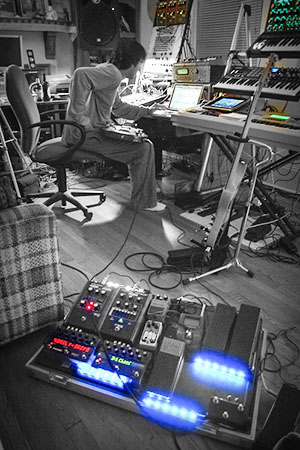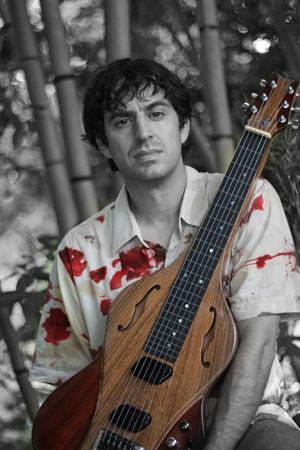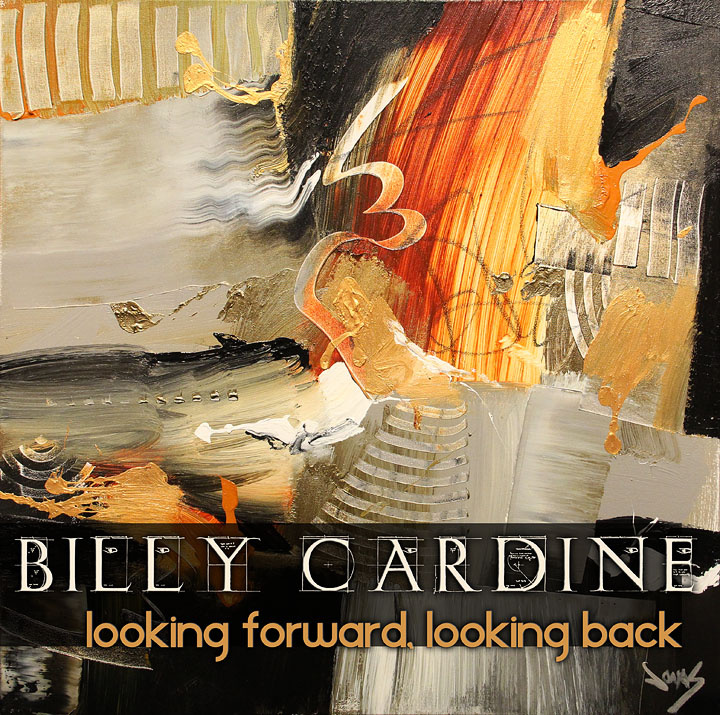Billy Cardine: Looking Forward, Looking Back
Moog Lap Steel powers groundbreaking EP exploring uncharted expanses of Ameritronica
By Chris Stack
ASHEVILLE, N.C. (September, 2011) Mix cutting-edge electronic vibration control technology with an instrument born on a train track, put it in the hands of musical omnivore Billy Cardine and the result is music with one foot in the past, one foot in the future and both ears wide open. Refining a lifetime of musical influences and liberating them with a combination of string and studio wizardry, his new EP Looking Forward, Looking Back shines a light on a musical future true to its roots yet constantly growing and evolving.
To know where you’re going though, you have to know where you’ve been…
Also in the ‘30s, the Sacred Steel tradition was born in African-American House of God churches, fueled by the low cost and highly expressive nature of this new instrument. From there it spread to many far-flung homes, including Indian classical music and American country and bluegrass, the genres in which it and its musical progeny, the dobro and pedal steel guitar are most closely associated.
Billy Cardine is an Americana/Bluegrass phenomenon who has performed everywhere from Carnegie Hall and the Kennedy Center to the Ryman Auditorium and Bonnaroo. He is a member of the renowned Americana band Acoustic Syndicate and leader of the new music ensemble The Billy Sea. He also studied in India and will perform at the 2011 Bangaluru International Arts Festival with chitravina master Ravikiran. Billy was instrumental in the development of the Moog Lap Steel and played an early prototype for its debut at Moogfest 2010.
“In one of those moments of wonderful synchronicity, I met Billy about the same time I finished the first Moog lap steel prototype which I had dubbed The Monster” said Moog Music’s Chief Engineer, Cyril Lance. “Billy and I got together and the first music he made on this crude instrument was stunning. It was immediately clear that not only was Billy perfect for this instrument, but the instrument was perfect for Billy. This began an extremely rewarding collaboration that resulted in the current Moog Lap Steel.
Combining the unique expressive qualities of the lap steel with the innovations of the Moog Guitar results in an instrument with unlimited sonic potential. Like the Moog Guitar, it is in not a guitar synthesizer, but features an onboard Moog filter (with control voltage input) that places it firmly in the Moog family tree and allows for some amazing creative connectivity with devices ranging from theremins to massive modular synthesizers.
The EP kicks off with the opening track “Moolodious” whose soaring melodies and pulsating beats sweep the listener along so thoroughly that it is easy to miss the technology behind the magic. While the Moog Lap Steel plays long anthemic notes that seem to defy the laws of physics, its big brother The Moog Guitar cranks out rhythms that, although created using advanced modular synthesis techniques (routing beat-synced control voltage signals from ProTools to The Moog Guitar’s onboard analog filter), are still very much the product of strings, a pick and a guitarist’s callused fingertips… in this case, the fingertips of Moog’s Cyril Lance.
“Jet Li”, the second track moves from Americana to Asiana. Inspired by the fluid movements of martial artist Jet Li, it starts with the low rumble of Moog Taurus Bass Pedals and a unique melody created with a two-handed phrasing technique impossible on an instrument without the precise sustaining abilities of The Moog Lap Steel. This may be the first recording in history in which a lap steel gets mistaken for an erhu.
The title track “Looking Forward, Looking Back” takes the Moog Lap Steel and Moog Guitar in a new direction. As it unfolds, the Lap Steel’s timbre is more reminiscent of a dobro while the Moog Guitar takes on a surreal, funky banjo-like role. When the long, sustained-note melody comes in, being played on the same instrument with the same strings creates a pleasing timbral cohesiveness.
“Stacks”, the most electronic of the tracks, showcases the instrument at play with its other Moog siblings. Built on an analog filtered drum beat, the Moog Lap Steel intertwines with the sounds of the Moog Guitar and Slim Phatty synthesizer while a Little Phatty synth generates a beat-synced control voltage making the Lap Steel’s filter dance in time with the rhythm. Meanwhile other keyboards and vocal processors fill out a soundscape proving that analog and digital can get along quite nicely.
The closing track, “The Curious Boo” was written on the original Moog prototype and combines sacred steel feel with an Indian approach to slide guitar phrasing. A Moog MF-102 ring modulator adds a unique metallic edge to these fluid lines.
The Roman god Janus, for whom the month January was named, is depicted as having two heads, one looking into the past and the other into the future, making him the archetype of beginnings, transitions and gateways (and New Year’s parties). When listening to “Looking Forward, Looking Back”, it’s hard not to hear the music in a similar light… as a harbinger of new beginnings, transitions and gateways… as a new voice… as “Ameritronica”. It’s also hard not to hear it as just damn good music.
Looking Forward, Looking Back is available from Indidog Records through bandcamp at:
http://billycardine.bandcamp.com/album/looking-forward-looking-back
Visit billycardine.com for more information.




